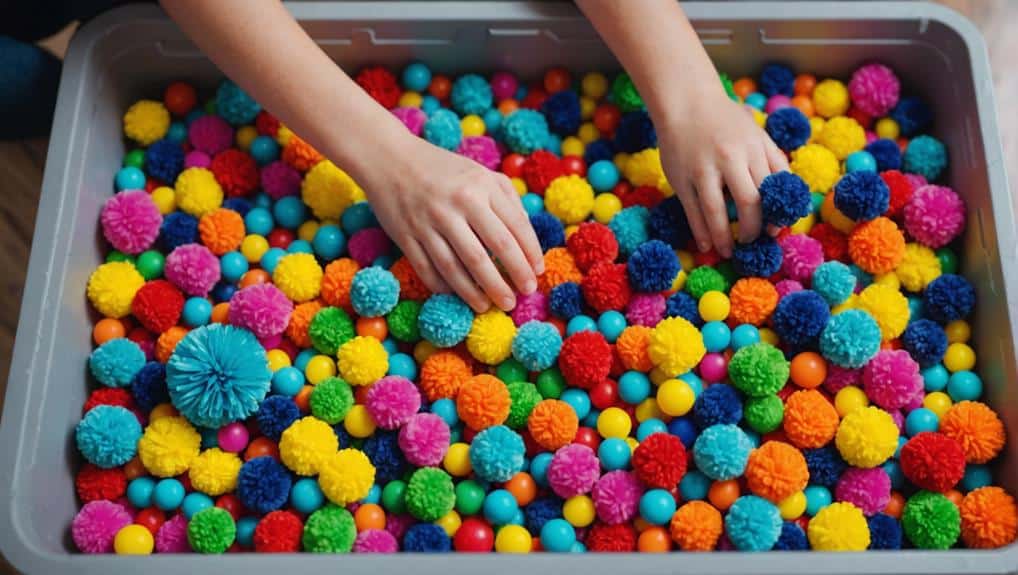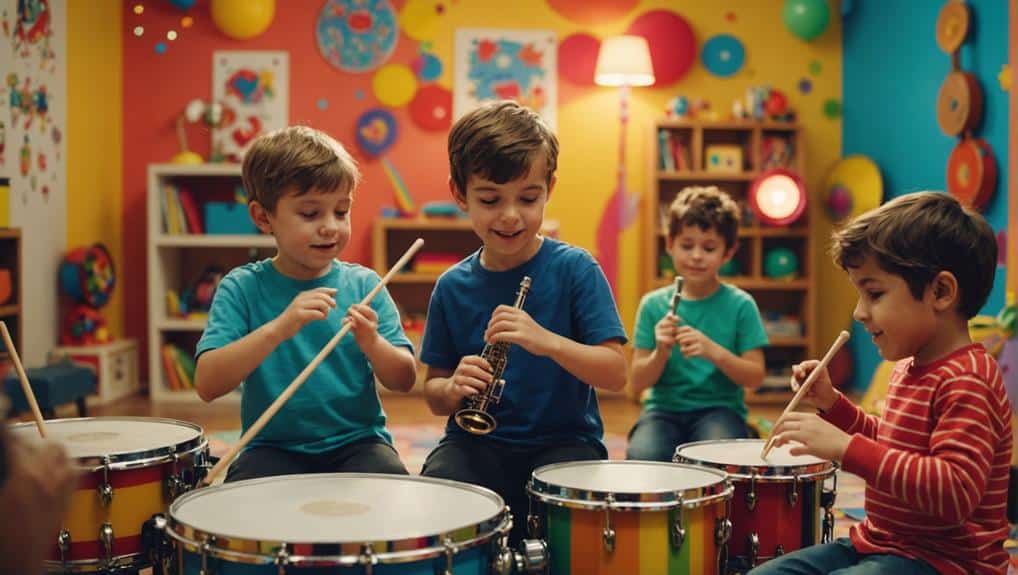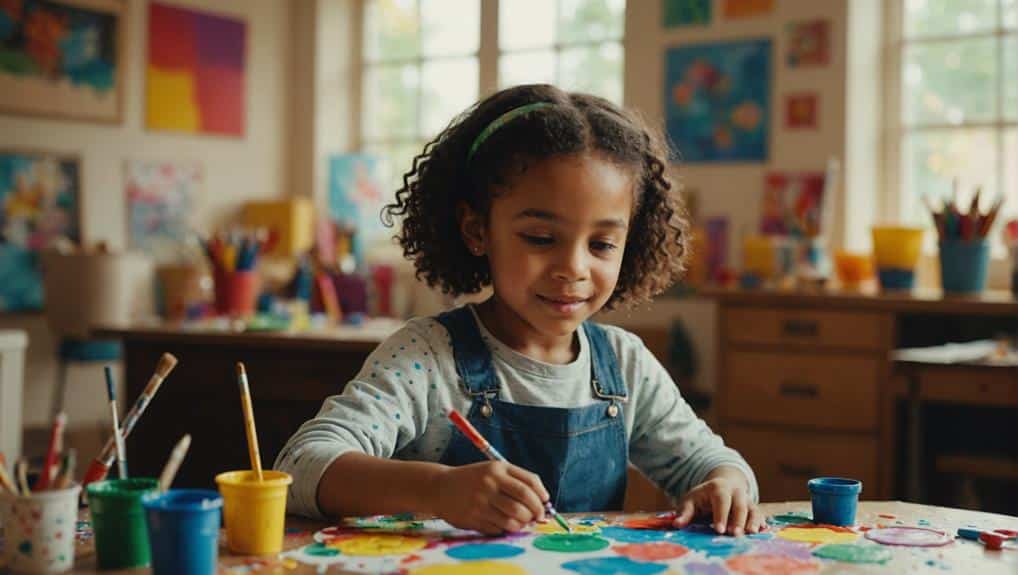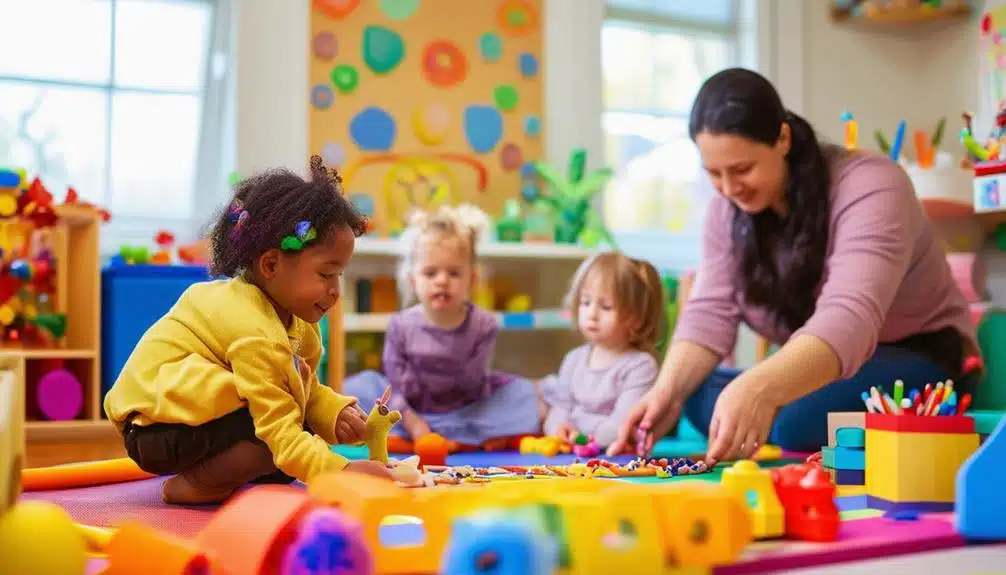Fun DIRFloortime techniques foster children’s development through engaging, evidence-based activities. Peekaboo games enhance cognitive and language development by promoting anticipation and vocal interactions. Bubble play encourages social interaction and sensory exploration, while sensory bins stimulate fine motor skills and mental processing.
Role-playing scenarios develop problem-solving skills and communication. Building forts nurtures psychological development and parent-child collaboration. Musical activities support social engagement and sensory integration. Art projects encourage fine motor development and creativity. Learn more about how these fun DIRFloortime techniques can help your child’s growth.
Key Takeaways
- Sensory Bins: Encourage exploration and fine motor skills through tactile play with various materials, such as rice, sand, or water.
- Role-Playing Scenarios: Enhance communication and cognitive development by acting out different characters and situations.
- Building Forts: Foster problem-solving, autonomy, and emotional development by collaborating to create imaginative spaces.
- Musical Activities: Develop social interaction and communication skills through singing, dancing, and playing instruments together.
- Art Projects: Promote fine motor skills, emotional expression, and confidence through creative activities like drawing, painting, and crafting.
Peek-a-Boo Games
Engaging in Peek-a-Boo games is a foundational activity that promotes social interaction and cognitive development in young children. This seemingly simple play technique has developmental benefits, making it a valuable tool for caregivers and educators.
During Peek-a-Boo, the child learns about object permanence, the understanding that objects continue to exist even when invisible. This cognitive milestone lays the groundwork for more complex problem-solving skills later.
Moreover, Peek-a-Boo fosters joint attention, a pivotal aspect of social engagement, where the child and caregiver focus on the same action. This shared focus enhances the child’s psychological development by creating shared enjoyment and connection moments.
The elements of surprise and anticipation inherent in Peek-a-Boo also teach children about different feeling responses, contributing to a broader sentiment vocabulary.
Additionally, the game strengthens the bond between child and caregiver through these interactive, joyful experiences. Children learn to anticipate the caregiver’s actions as they play and experience the joy and security of consistent, predictable interactions.
Hence, Peek-a-Boo is more than just a game; it is a critical building block in a child’s developmental journey.
Bubble Play

Bubble play offers a versatile approach to supporting sensory exploration, social interaction, and developmental milestones in children. This adaptable activity can seamlessly integrate into DIR/Floortime sessions, promoting engagement and creativity while addressing various developmental levels.
Blowing bubbles encourages children to develop oral motor skills for speech and feeding. Tracking and popping bubbles enhances visual tracking abilities, a key component in developing reading and writing skills. Additionally, bubble play can serve as a calming and soothing sensory experience, regulating emotions and promoting relaxation.
Key benefits of bubble play include:
- Sensory Exploration: Engages multiple senses, providing a rich, tactile, and visual experience.
- Social Interaction: Encourages turn-taking, joint attention, and communication between children and caregivers.
- Oral Motor Skills: Strengthens muscles involved in speech and eating by blowing bubbles.
- Visual Tracking Abilities: Enhances focus and coordination by following the movement of bubbles.
- Emotional Regulation: Offers a calming activity that can help children manage their feelings and reduce anxiety.
Incorporating bubble play into DIR/Floortime sessions can effectively support a child’s developmental journey, fostering an environment emphasizing sensory exploration and emotional growth.
Sensory Bins

Sensory bins provide a multifaceted approach to supporting children’s developmental needs by engaging their senses and promoting fine motor skills through hands-on exploration. These bins, filled with materials such as rice, beans, or sand, offer a rich environment for sensory exploration. Sensory bins foster the development of fine motor skills critical to daily tasks by allowing children to scoop, pour, and sort.
The versatility of sensory bins makes them invaluable tools in home and educational settings. Activities can be carefully tailored to meet each child’s preferences and needs, whether for calming purposes or stimulating engagement. For instance, an excellent, smooth sand bin can provide a soothing experience, while brightly colored rice can be stimulating and visually engaging.
Beyond motor skills and sensory engagement, sensory bins also encourage imaginative play. Children can transform a simple bin into a miniature world, sparking creativity and narrative thinking. This hands-on sensory experience captivates their attention and supports cognitive development and problem-solving skills.
Role-Playing Scenarios

Role-playing scenarios in DIR/Floortime allow children to engage in imaginative storytelling, fostering creative thinking and social skills.
Children can safely practice communication, cooperation, and conflict resolution by playfully exploring feelings and true-to-life situations.
Tailoring these scenarios to unique interests and challenges guarantees customized learning experiences that support heartfelt and cognitive development.
Imaginative Storytelling Together
Engaging in imaginative storytelling through role-playing scenarios within DIR/Floortime therapy dramatically enhances children’s social skills, creative thinking, and feeling expression. This form of play provides an invaluable opportunity for children to explore rich, creative narratives while simultaneously developing vital developmental skills.
Role-playing scenarios allow children to:
- Explore different roles and perspectives: Children enhance their empathy and understanding of others by stepping into various characters.
- Boost social skills and communication: Interacting with peers or adults in these scenarios fosters better verbal and non-verbal communication.
- Enhance creative thinking: Crafting stories and envisioning different outcomes stimulate children’s imaginations and creativity.
- Develop problem-solving skills: Navigating through storylines and resolving conflicts within these tales encourages cognitive growth and critical thinking.
- Facilitate emotional expression: Expressing various feelings through characters helps children understand and manage their emotions.
Through imaginative storytelling, children enjoy play and engage in meaningful learning experiences. This form of role-playing allows them to practice and refine skills in a supportive, child-centered environment. Evidence shows that such dynamic interactions in DIR/Floortime therapy significantly contribute to a child’s holistic development, ultimately fostering a well-rounded growth trajectory.
Exploring Emotions Playfully
Exploring feelings through playful role-playing scenarios in DIR/Floortime therapy enables children to understand their own and others’ feelings better, thereby fostering intelligence and empathy. This interactive method is instrumental in promoting development by allowing children to act out various roles and emotions in a safe and supportive environment.
Role-playing scenarios provide a structured yet flexible platform for children to practice expressing emotions, such as joy, sadness, anger, and fear, in a controlled manner. This helps them learn to manage their feelings effectively, enhancing their intelligence. Through these activities, children can experiment with different responses, offering valuable opportunities for creative expression and the development of social skills.
The empathetic aspect of role-playing is especially significant, as children not only explore their feelings but also gain insights into the emotions of others. This understanding promotes empathy and improves their ability to relate to peers and adults.
Furthermore, the interactive nature of these scenarios fosters a collaborative learning environment, enriching the therapeutic experience and making learning both engaging and effective. Ultimately, role-playing in DIR/Floortime is a powerful tool for holistic development.
Real-Life Situations Recreated
Recreating genuine-life situations within DIR/Floortime therapy offers children a practical and engaging way to develop essential social skills and problem-solving abilities. By incorporating role-playing scenarios, therapists and caregivers can simulate everyday interactions such as going to the grocery store, playing at the park, or having a pretend tea party. This hands-on approach allows children to practice navigating various social situations, expressing emotions, and communicating effectively.
Role-playing scenarios provide a structured environment where children can safely explore and enhance their empathy, perspective-taking, and conflict-resolution skills. These activities encourage creativity and imagination while fostering heartfelt connections and improving social interactions.
Key benefits of role-playing scenarios in DIR/Floortime include:
- Active Participation: Children engage directly, making decisions and solving problems in real time.
- Empathy Development: By taking on different roles, children learn to understand and share the feelings of others.
- Conflict Resolution: Structured scenarios offer opportunities for children to practice resolving disputes amicably.
- Enhanced Social Skills: Regular practice in varied scenarios builds confidence and competence in social interactions.
- Safe Exploration: The structured environment ensures children can experiment and learn without real-world consequences.
Through these role-playing activities, children develop critical social skills and build confidence and competence in everyday interactions.
Building Forts

Building forts offers an excellent chance for children to unleash their creativity while interacting with different materials, like blankets, pillows, and cardboard boxes.
This activity boosts imaginative play and promotes parent-child teamwork, enhancing communication and social skills.
Moreover, the sensory-rich setting of the fort building encourages tactile exploration and spatial awareness, making it a holistic developmental activity.
Materials and Setup
Creating a stimulating and imaginative play environment begins with selecting versatile materials such as sheets, blankets, and cushions for constructing forts. These everyday items form the foundation for engaging and practical Floortime sessions, promoting creative play and imagination.
Fort building transforms simple materials into an essential environment where children can immerse themselves in tactile exploration and sensory development.
Critical materials for fort building include:
- Sheets and Blankets: Lightweight and easy to drape, perfect for creating the structure.
- Cushions and Pillows: Provide comfort and stability, essential for a cozy fort.
- Clothes Pins and Clips: These are useful for securing sheets and blankets in place efficiently.
- String Lights or Flashlights: Add a sensory element and create a magical ambiance.
- Cardboard Boxes: Versatile for adding walls, tunnels, or additional rooms within the fort.
Utilizing these materials not only makes fort building accessible but also fosters cooperative play as children work together to construct their exceptional space. Such collaborative efforts enhance problem-solving skills and spatial awareness, distinctive components of child development.
Imaginative Play Benefits
Engaging in fort-building activities during Floortime facilitates imaginative play, fostering children’s creativity, problem-solving skills, and sensory development. Constructing forts provides a sensory-rich experience that enhances tactile exploration and spatial awareness. Children manipulating blankets, pillows, and other materials engages their senses and improves fine motor skills.
Moreover, fort building promotes social development through cooperation and communication. When working with peers or adults, children learn to share ideas, negotiate roles, and solve conflicts, enhancing their interpersonal skills. This collaborative effort fosters a sense of community and belonging.
Creating a fort allows children to engage in self-directed play and bolsters their autonomy and independence. Children gain confidence in their abilities by making decisions and solving problems independently. This self-assurance translates into other areas of life, encouraging a proactive and resilient mindset.
Ultimately, forts offer a safe, secluded space where children can regulate their feelings and explore imaginative scenarios. This autonomy in play supports emotional development and helps children build resilience.
Parent-Child Collaboration
Parent-child collaboration in constructing forts enhances children’s creativity, problem-solving, and teamwork skills. This interactive play activity supports cognitive development and fosters heartfelt connections and meaningful interaction between parents and children.
Building forts involves imaginative play and role-playing, creating a platform for shared experiences that enrich parent-child relationships. Moreover, the sensory exploration and fine motor skills required for fort construction contribute to a sensory-rich environment, allowing children to explore and play creatively.
The benefits of building forts together include the following:
- Creativity and Imagination: Encourages children to think creatively and use their imagination.
- Problem-Solving Skills: Children are challenged to find solutions and work through obstacles.
- Teamwork and Cooperation: Teaches children the value of collaboration and sharing ideas.
- Heartfelt Bonding: Strengthens the heartfelt connections between parent and child through meaningful interaction.
- Sensory and Motor Skills: Manipulating various materials enhances sensory exploration and fine motor development.
Musical Activities

Musical activities in DIR/Floortime therapy provide an invaluable opportunity to enhance children’s social interactions and communication skills through sensory-rich, engaging play. Utilizing instruments such as drums, shakers, or xylophones enables children to experience sensory-rich interactions, fostering expressive expression and creativity. Singing songs or crafting musical stories can further support these developmental milestones, nurturing the child’s ability to express feelings and their imaginative capabilities.
Incorporating movement and dance into musical activities is essential for motor skills development and body awareness. These activities encourage children to move their bodies in rhythm with the music, enhancing gross and fine motor skills while promoting a positive environment for interactive play sessions. The table below outlines various musical activities and their associated developmental benefits:
| Musical Activity | Developmental Benefit |
|---|---|
| Playing drums | Enhances motor skills, rhythmic sense |
| Shakers and tambourines | Promotes sensory-rich experiences |
| Singing songs | Boosts communication skills |
| Musical storytelling | Encourages creativity and expressive expression |
| Movement and dance | Supports motor skills development and body awareness |
Art Projects

Art projects in DIR/Floortime therapy offer children a valuable avenue for creativity, self-expression, and sensory exploration while supporting the development of fine motor skills and hand-eye coordination. Engaging in such activities allows children to explore a variety of textures, colors, and materials, including paints, crayons, markers, and clay, thereby enhancing their sensory experiences.
These art projects serve as an expressive outlet for emotional expression, allowing children to communicate feelings and thoughts they might struggle to verbalize. Therapists can significantly enhance the child’s self-esteem and confidence by tailoring art activities to a child’s interests and preferences. The focused nature of these projects offers a structured yet flexible environment that fosters emotional and developmental growth.
Below are some key benefits of incorporating art projects in DIR/Floortime therapy:
- Creativity and Self-Expression: Encourages distinct and individual artistic creations.
- Sensory Exploration: Engages multiple senses through diverse materials and textures.
- Fine Motor Skills: Enhances dexterity and hand-eye coordination by manipulating art tools.
- Emotional Expression: Provides a safe, expressive outlet for conveying complex emotions.
- Boost Self-Esteem: Increases confidence by allowing children to create work that reflects their interests and preferences.
Frequently Asked Questions
What are Some Examples of Fun DIRFloortime Techniques?
An example of DIR/Floortime therapy involves a caregiver engaging in a child’s preferred activity, such as building blocks, while emphasizing connection and communication. Thus, developmental progress is facilitated within a sensory-friendly and child-centered environment.
What Is the Difference Between ABA and Dirfloortime?
ABA and DIRFloortime are complementary methodologies; ABA emphasizes behavior modification through structured reinforcement, while DIRFloortime nurtures psychological and social growth via child-led, interactive play, fostering holistic development and deeper relational bonds.
What Is the Age Range for Dir Floortime?
DIR/Floortime is suitable for children from infancy through adolescence. It is adaptable to specific developmental needs and interests, fostering personal connections and developmental progress across a broad age range, including children with developmental challenges.
What Is DIR/Floortime?
DIRFloortime is a child-centered therapeutic approach emphasizing developmental stages, personal differences, and relationships. It involves following the child’s lead to build emotional connections, support distinctive strengths, and foster cognitive, social, and emotional development through interactive play.
Conclusion
Fun DIRFloortime techniques are research-supported developmental approaches that enhance an autistic child’s social, psychological, and cognitive development. Pioneered by Dr. Stanley Greenspan and Serena Wieder, these strategies focus on fostering emotional connections and meaningful interactions. By engaging in activities like peekaboo games and bubble play, children with autism can develop their language skills and cognitive abilities.
Using fun DIRFloortime techniques like sensory bins and role-playing scenarios helps children build problem-solving skills and emotional expression. These techniques create a supportive environment that addresses each child’s sensory preferences and developmental milestones. This approach emphasizes the importance of emotional development and effective strategies for improving communication and social interactions in children with autism spectrum disorders.
The Relationship-Based (DIR) model, central to Floortime therapy, provides opportunities for children to explore and learn through play-based interactions. Creative activities like building forts and engaging in musical play foster holistic development, including motor skills and cognitive growth. These practical interventions guide parents in supporting their child’s developmental journey, promoting essential skills and adaptive abilities in a safe and nurturing environment.


Recent Comments